This content originally appeared on Radio Free Asia and was authored by Radio Free Asia.
This post was originally published on Radio Free.
This content originally appeared on Radio Free Asia and was authored by Radio Free Asia.
This post was originally published on Radio Free.
This content originally appeared on Human Rights Watch and was authored by Human Rights Watch.
This post was originally published on Radio Free.
This content originally appeared on Radio Free Asia and was authored by Radio Free Asia.
This content originally appeared on Radio Free Asia and was authored by Radio Free Asia.
This post was originally published on Radio Free.
This content originally appeared on Democracy Now! and was authored by Democracy Now!.
This post was originally published on Radio Free.
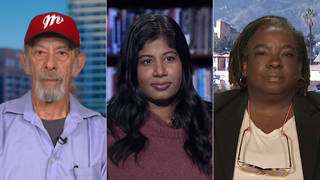
Organizers across the United States are planning a massive day of May Day protests against the Trump administration. Organizers say that they have broad support from groups targeted by the administration, including immigrants, federal workers and more. “Instead of attacking only one community … they are attacking everybody at the same time, and that enabled us to gather a really broad coalition,” says Jorge Mújica, strategic organizer for Arise Chicago.
In New York, organizers are calling on people to march alongside them in Foley Square. “We need to fight this corporate takeover,” says Nisha Tabassum, lead organizer for worker issues at Make the Road New York. “We are the many; they are the few.”
Los Angeles organizers are expecting hundreds of thousands of protesters to join them in opposition to Trump’s policies. “We are taking our power back,” says Georgia Flowers Lee, National Education Association vice president for United Teachers Los Angeles.
This content originally appeared on Democracy Now! and was authored by Democracy Now!.
This post was originally published on Radio Free.
This content originally appeared on Radio Free Europe/Radio Liberty and was authored by Radio Free Europe/Radio Liberty.
This post was originally published on Radio Free.
This content originally appeared on Radio Free Asia and was authored by Radio Free Asia.
This post was originally published on Radio Free.
This content originally appeared on Radio Free Asia and was authored by Radio Free Asia.
This post was originally published on Radio Free.
Asia Pacific Report
Protesters at the Aotearoa New Zealand’s weekly “free Palestine” rallies today gave a tribute to poet Mahmoud Darwish — the “liberation voice of Palestine” — and marked the sixth anniversary of the Christchurch mosque massacre when a lone terrorist gunned down 51 people at Friday prayers.
Organisers thanked the crowd for attending the rally in what has become known as “Palestine Corner” in the downtown Komititanga Square in the heart of Auckland Tāmaki Makaurau in the 75th week of protests.
This was one of more than 20 Palestinian solidarity events happening across the motu this weekend.
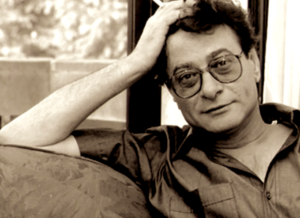
The organisers, of the Palestine Solidarity Network Aotearoa (PSNA), said the rallies would continue until there was a “permanent ceasefire through Palestine” — Gaza, East Jerusalem and occupied West Bank and for a just political outcome for a sovereign Palestinian state.
The poet, writer and activist Mahmoud Darwish (1941-2008) was born on 15 March 1941 in the small Palestinian Arab and Christian village of al-Birwa, east of Acre, in what is now western Galilee in the state of Israel after the attacks by Israeli militia during the Nakba.
He published his first book of poetry, Asafir Bila Ajniha (“Birds Without Wings”), at the age of 19. Over his writing career, he published more than 30 volumes of poetry and eight books of prose.
By 1981, at the age of 40, he was editor of Al-Jadid, Al Fajir, Shu’un Filisiniyya and Al-Karmel.
He won many awards and his work about the “loss of Palestine” has been translated and published in 20 languages.
Darwish is credited with helping forge a “Palestinian consciousness” and resistance to Israeli military rule after the 1967 Six-Day War.
Several speakers read poetry by Darwish or their own poems dedicated to Palestine, including Kaaka Tarau (“Identity Card”), Chris Sullivan (“To My Mother”), Jax Taylor (own poem), Besma (own poem), Audrey (“I am There”), Achmat Esau (“I Love You More”), and Veih Taylor (“Rita and the Rifle”).
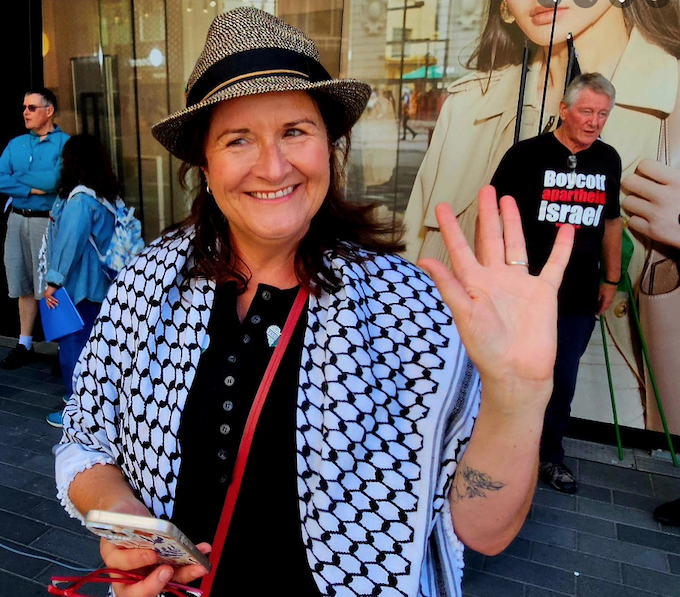
Journalist David Robie provided a short introduction to Darwish’s life and works, and he also spoke about the arrest of former Philippines president Rodrigo Duterte this week who is now in a cell in The Hague awaiting trial on International Criminal Court (ICC) charges of crimes against humanity over the extrajudicial killings of Filipinos during the so-called “war against drugs”.
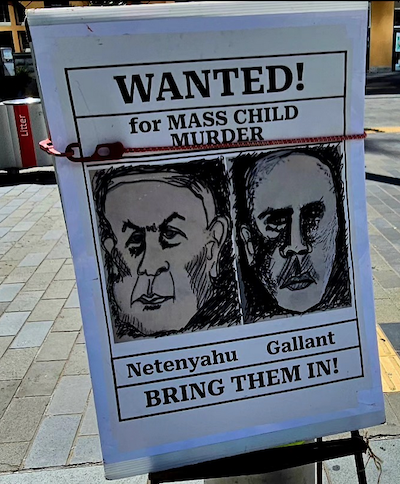
“This arrest is really significant as it gives us hope,” he said.
“Although the wheels of justice might seem to move slowly, the arrest of Duterte gives us hope that one day the ICC arrest warrants issued last November for Israeli Prime Minister Benjamin Netanyahu and former defence minister Yoav Gallant will eventually be served, and they will be detained and face trials in The Hague.”
South African-born teacher and activist Achmat Esau reminded the crowd of the significance of the date — March 15, the sixth anniversary of the Christchurch massacre when a lone Australian terrorist shocked the nation by killing 51 people at Friday prayers in two mosques with scores injured, or wounded by gunfire.
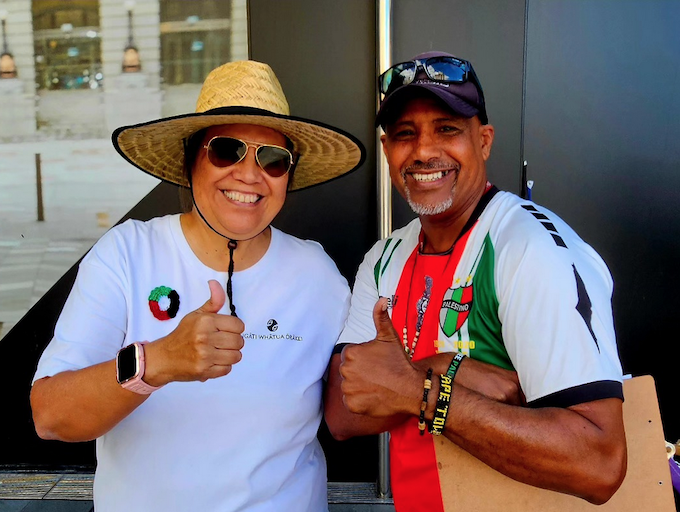
The gunman pleaded guilty at his trial and is serving a life sentence without parole — the first such sentence imposed in New Zealand.
Esau shared a poem that he had written to honour those killed and wounded:
Memory, by Achmat Esau
51 …
the victims
49 …
the injured
15 …
the day
1 …
the terror
2 …
the masjids
5 million …
the impact
Hate …
the reason
Murder …
the aim
Love …
the response
Hope …
the result
Justice …
the call
51 …
the Martyrs!
The MC, Kerry Sorensen-Tyrer, praised the “creative people” and called on them to “keep creating and processing their feelings into something beautiful and external to honour the people of Palestine”.
Organisers were Kathy Ross and Del Abcede.
This content originally appeared on Asia Pacific Report and was authored by APR editor.
This post was originally published on Radio Free.
This content originally appeared on Radio Free Europe/Radio Liberty and was authored by Radio Free Europe/Radio Liberty.
This post was originally published on Radio Free.
This content originally appeared on Human Rights Watch and was authored by Human Rights Watch.
This post was originally published on Radio Free.
This content originally appeared on Radio Free Europe/Radio Liberty and was authored by Radio Free Europe/Radio Liberty.
This post was originally published on Radio Free.
This content originally appeared on Radio Free Europe/Radio Liberty and was authored by Radio Free Europe/Radio Liberty.
This post was originally published on Radio Free.
This content originally appeared on Radio Free Europe/Radio Liberty and was authored by Radio Free Europe/Radio Liberty.
This post was originally published on Radio Free.
This content originally appeared on Radio Free Europe/Radio Liberty and was authored by Radio Free Europe/Radio Liberty.
This post was originally published on Radio Free.
In a video released Saturday on his 89th birthday, the Dalai Lama said he was recovering from his recent knee replacement surgery, felt “physically fit” and thanked Tibetans around the world for praying for him.
“I am nearly 90 now, except for the issues with my knee, I am basically in good health,” the Tibetan spiritual leader said in the five-minute video, his first public statement since undergoing successful knee surgery on June 28 at a top New York City hospital.
“Despite the surgery, I feel physically fit,” the Dalai Lama said, allaying concerns about his overall health. “So, I wish to ask you to be happy and relaxed.”
“Today, Tibetans inside and outside of Tibet are celebrating my birthday with much joy and festivity,” he said, speaking in Tibetan. “I would like to thank all my fellow Tibetans, inside and outside Tibet, for your prayers on my birthday.”
Several global leaders, including Indian Prime Minister Narendra Modi and U.S. Secretary of State Antony Blinken, sent birthday greetings.
“Through his promotion of nonviolence and compassion, as well as his commitment to advancing human rights for all, His Holiness serves as an inspiration for the Tibetan community and many around the world,” Blinken said in a statement.
Modi wrote on X: “Sent my greetings to His Holiness the Dalai Lama on the occasion of his 89th birthday. Pray for his quick recovery after his knee surgery, good health, and long life.”
The Nobel Peace Prize winner enjoys strong support in the United States, where prominent lawmakers have spoken out about human rights issues in Tibet.
China, however, considers him a separatist and has criticized those who meet with him, including a delegation of U.S. lawmakers who recently met with him in Dharamsala, India.
Last month, the U.S. Congress passed a bill urging China to re-engage with the Dalai Lama and other Tibetan leaders to resolve its dispute over the status and governance of Tibet. China-Tibet talks ground to a halt in 2010.
“We stand by His Holiness and the Tibetan community as they seek to preserve Tibetans’ distinct cultural, religious, and linguistic heritage,” said U.S. Special Coordinator for Tibetan Issues Uzra Zeya, in a birthday greeting.
Thousands converge
At the Park Hyatt Hotel in New York, where the Dalai Lama is recovering, a steady stream of Tibetans and Buddhist devotees have gathered every day since his arrival in the United States on June 23, braving the heat to walk around the hotel and offer prayers.
On Saturday, to mark his birthday, devotees converged in even larger numbers to offer hundreds of katags, white Tibetan silk scarves, and bouquets of flowers outside the hotel, which many referred to as their “temple.”

On Friday evening, on the eve of his 89th birthday, at least a thousand Tibetans gathered in New York’s Times Square to witness two giant billboards carrying birthday messages written in Tibetan and English.
As the messages flashed at midnight, the crowd – many of whom were decked out in Tibetan dress and waving the Tibetan flags – cheered, sang, danced and chanted prayers.
Reflecting on his life so far, the Dalai Lama said in the video he was resolved to continue to give his best to promote Buddhism and the well-being of the Tibetan people.
He also acknowledged the “growing interest” in the Tibetan cause in the world today, and felt he had made a “small contribution” toward that.
‘Year of Compassion’
In Dharamsala, India, Sikyong Penpa Tsering, the leader of the Central Tibetan Administration, the Tibetan government-in-exile, announced plans to celebrate the Dalai Lama’s 90th birthday next year as the “Year of Compassion” marked by a series of year-long events starting in July 2025.
The Dalai Lama has said that he will provide clarity around his succession, including on whether he would be reincarnated and where, when he turns 90.

China – which annexed Tibet in 1951 and rules the western autonomous region with a heavy hand – says only Beijing can select the next spiritual leader of Tibetan Buddhists, as it seeks to control the centuries-old selection process for religious leaders, including the Dalai Lama.
Tibetans, however, believe the Dalai Lama chooses the body into which he will be reincarnated, a process that has occurred 13 times since 1391, when the first Dalai Lama was born.
The 14th Dalai Lama fled Tibet amid a failed 1959 national uprising against China’s rule and has lived in exile in Dharamsala, India, ever since. He is the longest-serving Tibetan Buddhist spiritual leader in Tibet’s history.
Ever since, Beijing has sought to legitimize Chinese rule through the suppression of dissent and policies undermining Tibetan culture and language.
Beijing believes the Dalai Lama wants to split off the Tibet Autonomous Region and other Tibetan-populated areas in China’s Sichuan, Qinghai, Yunnan, and Gansu provinces – which Tibetan refer to as “Amdo” and “Kham” – from the rest of the country.
However, the Dalai Lama does not advocate for independence but rather proposes what he calls a “Middle Way” that accepts Tibet’s status as a part of China and urges greater cultural and religious freedoms, including strengthened language rights.
Blinken said in his statement Saturday that the “The United States reaffirms our commitment to support efforts to preserve Tibetans’ distinct linguistic, cultural, and religious heritage, including the ability to freely choose and venerate religious leaders without interference.”
Additional reporting by Tashi Wangchuk, Dolkar, Nordhey Dolma, Dickey Kundol, Yeshi Dawa, Sonam Singeri, Dorjee Damdul, Tenzin Dickyi for RFA Tibetan. Written and edited by Tenzin Pema, edited by Malcolm Foster.
This content originally appeared on Radio Free Asia and was authored by By RFA Tibetan.
This post was originally published on Radio Free.
Comprehensive coverage of the day’s news with a focus on war and peace; social, environmental and economic justice.
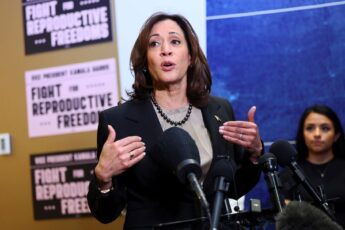
The post The Pacifica Evening News, Weekdays – June 24, 2024. Harris marks second anniversary of Dobbs abortion decision at Maryland campaign event. appeared first on KPFA.
This content originally appeared on KPFA – The Pacifica Evening News, Weekdays and was authored by KPFA.
This post was originally published on Radio Free.
Like two heavyweight boxers, the United States and Iran circle the ring — flexing their muscles without stepping close enough to actually trade blows. It is clear that neither wants to fight, but they also have no interest in settling their stark differences.
That is how experts say Washington and Tehran have dealt with each other for more than four decades, only changing their stance when it is mutually beneficial.
Tensions have soared between the two foes, who have no formal diplomatic ties, amid the fallout from Israel’s devastating war in the Gaza Strip. But despite calls for de-escalation, observers say there is little room for détente.
“I’ve rarely seen a situation in which the tensions have been so high and the exit ramps are nearly nonexistent and there were no real channels of communication between the two sides,” said Ali Vaez, director of the Iran project at the International Crisis Group.
“And that makes the current situation even more dangerous, because there’s plenty of space for miscommunication and misunderstanding,” Vaez added.
Current tensions in the Middle East have had deadly consequences even as each side tries to avoid getting drawn into a direct military confrontation.
The United States has hit Iran-backed militants in response to attacks against U.S. forces and interests in the region, including the deaths of three U.S. soldiers in Jordan last month, while underscoring that its aim is de-escalation.
Iran, which like the United States has said that it does not want war, has continued to back militant groups that make up its so-called “axis of resistance” against Israel and the West, while calling for diplomacy to resolve the crisis.
Tehran and Washington have carefully avoided direct conflict, but are in no position to work out their differences even if they wanted to, experts say.
Washington and Tehran have not had formal diplomatic ties since the 1979 Islamic Revolution, leaving them to negotiate through back-channels or third states when needed.
But political and ideological pressures at home — amplified ahead of a parliamentary vote in Iran in March and a presidential election in the United States in November — has meant that neither side is looking to back away any time soon from the stark red lines the two have drawn.
Avenues For Diplomacy
“There are ways that communication can be had between the two countries, and they do so,” said Alex Vatanka, director of the Iran Program at the U.S.-based Middle East Institute. “But they tend to do it on select files, or moments of crisis.”
Vatanka said those lines of communication include Iran’s envoy to the United Nations who resides in New York and the Swiss Embassy in Tehran which handles American interests in the Islamic republic. There are also third-party mediators, including Qatar, Oman, and Iraq, he said.
The U.S.-Iran prisoner swap worked out in September, which followed years of secret negotiations involving Gulf states and Switzerland, is the most recent example.
Under that deal, four Americans held hostage in Iran were released in exchange for Washington unfreezing $6 billion in Iranian oil revenue held up in South Korea.
As part of the agreement, according to Vaez, “Iran committed to rein in groups that were targeting U.S. interests in Iraq and Syria” and Washington received a commitment that Tehran would not supply ballistic missiles to Russia for use in Moscow’s war against Ukraine.
Shortly after Iran-backed Hamas, which is considered a terrorist organization by the United States and the European Union, carried out its deadly assault on Israel on October 7, the unfrozen Iranian funds came under intense scrutiny. Republicans in the United States who are gearing up for the presidential election in November have been particularly vocal in criticizing the deal worked out by the administration of Democratic President Joe Biden.
In response, Washington worked out an agreement with Qatar, where the unfrozen Iranian funds were moved and to be released only for humanitarian purposes, to prevent Tehran from accessing them at all. But the deal has remained a hot-button issue.
The Gaza war and the ensuing resumption of attacks on U.S. forces and interests by Iran-backed groups have attracted even more political discord.
After Israel’s large-scale offensive against Hamas in the Gaza Strip that has killed more than 27,000 Palestinians, Iran-backed militant groups have carried out attacks in solidarity with Hamas. The Iran-backed Huthi rebels in Yemen have targeted maritime shipping and U.S. naval forces in the Red Sea. Meanwhile, Iran-backed militias in Iraq killed three U.S. soldiers in Jordan in a drone attack.
That, in turn, has led to U.S. and U.K. attacks on Huthi targets in Yemen, and by the United States against Iran-backed militias and Iranian-linked sites in Syria and Iraq.
Iran, for its part, has said that the axis of resistance, which it denies directing, would continue to carry out strikes until a permanent cease-fire is worked out to stop what it calls a genocide in Gaza. And in what was widely seen as a show of its capability to strike back in the event Iran itself is attacked, it has launched ballistic missile strikes against “enemy” targets in Iraq, Pakistan, and Syria, the latter of which showcased that Israel was within striking distance.
The recent spike in violence came after the United States had experienced “the longest period of quiet in the Middle East” from March until the Hamas assault on October 7, Vaez said.
That relative peace came about not because of displays of power, but because Iran and the United States were negotiating, Vaez said.
“It wasn’t because the U.S. had flexed its military muscle and deterred Iran, it was because it was engaged in diplomatic understandings with Iran that came to fruition and culminated in a detainee deal,” Vaez said.
Tehran and the United States, currently trading threats of ever-stronger responses, “are seeking to pressure each other into greater flexibility,” said Trita Parsi, co-founder of the Washington-based Quincy Institute for Responsible Statecraft.
“Both would like to get back to the truce they enjoyed prior to the October 7 attacks” by Hamas against Israel, Parsi said in written comments. “But whether the political will is available for real de-escalation remains unclear.”
“President Biden has been unmovable in his opposition to a cease-fire in Gaza thus far,” Parsi said, referring to mounting calls for a cessation of hostilities between Israel and Hamas. “And without such a cease-fire, real de-escalation remains very unlikely.”
Military Message
U.S. Secretary of State Antony Blinken said on February 6, halfway through his latest trip to the Middle East to reduce regional tensions, that a proposal for a temporary cease-fire put together with the help of Qatar and Egypt and presented to Hamas and Israel, was “possible and, indeed, essential.”
While details of the proposal have not been made public, Blinken said that the goal is to use any pause in fighting to address humanitarian and reconstruction needs in Gaza and “to continue to pave a diplomatic path forward to a just and lasting peace and security for the region.”
Asked by RFE/RL whether Washington is employing any diplomatic means, either directly or indirectly, to decrease tensions with Iran, a U.S. State Department spokesperson pointed to recent strikes carried out against Iranian-backed groups in Yemen, Syria, and Iraq.
“Our military response to the killing of three U.S. service members by Iran-aligned militia groups and our continued action to degrade the Huthis’ ability to threaten international shipping sends the clearest message of all: the United States will defend our personnel and our interests,” a U.S. State Department spokesman said in written comments on February 7.
“When we are attacked, we will respond strongly, and we will respond at a time and place of our choosing,” the spokesman said.
Prior to the deadly attack on the U.S. base in Jordan, there had been reports of Washington using third states to send a nonmilitary notice to Iran.
Shortly after the Hamas assault on Israel in October, the U.S. Senate majority leader, Chuck Schumer, said that a congressional delegation to China had asked Beijing to exert its influence with Tehran to prevent the Israel-Hamas conflict from spreading.
In early January, the Lebanese news publication Al-Ahed News quoted Iran’s ambassador to Syria as saying that a delegation from an unidentified Gulf state had carried a message from the United States seeking to reduce the risk of an expanded regional conflict.
The U.S. State Department spokesperson said that beyond the recent U.S. strikes, “our message to Iran, in public and in private, has been a singular one: cease your support for terrorist groups and militant proxies and partners.”
Washington welcomes “any efforts by other countries to play a constructive role in trying to prevent these Iran-enabled attacks from taking place,” the spokesperson added, but referred to White House national-security spokesman John Kirby’s February 6 comment that “I know of no private messaging to Iran since the death of our soldiers in Jordan over a week ago.”
Lack Of Vision
The limits of diplomacy between the United States and Iran, according to Vatanka, “is not a lack of the ability to communicate, the problem is a lack of vision” to repair relations.
For political reasons and for a long time, Vantanka added, neither side has been interested in mending the bad blood that has existed between the two countries going back to 1979.
“Right now, the White House cannot afford to talk to Iran at a time when so many of Biden’s critics are saying he’s too soft on the Iranian regime,” Vatanka said. “On the other hand, you’ve got an Iranian supreme leader who is 84 years old. He’s really keen on two things: not to have a war with the Americans, because he doesn’t think that’s going to go well for Iran or his regime. But at the same time, he doesn’t want to see the Americans return to Tehran anytime soon. Certainly not when he’s alive.”
This, Vatanka explained, is because Supreme Leader Ayatollah Ali Khameini “does not think the Americans want anything other than the fundamental objective of bringing about the end of the Islamic republic.”
The other major voice in Iranian foreign policy — the leaders of the Islamic Revolutionary Guards Corps — also see anti-Americanism as a worthwhile instrument to further their ideological and political aims at home and abroad, according to Vatanka.
“They think anti-Americanism is the ticket to mobilize the Islamic world around their flag and around their leadership,” Vatanka said.
More moderate voices when it comes to Iran’s foreign policy, Vatanka said, are labeled as traitors and weak and “are today essentially marginalized.”
This content originally appeared on News – Radio Free Europe / Radio Liberty and was authored by News – Radio Free Europe / Radio Liberty.
This post was originally published on Radio Free.
KYIV — Ukrainian officials on January 27 said Russia had intensified attacks in the past 24 hours, with a commander saying the sides had battled through “50 combat clashes” in the past day near Ukraine’s Tavria region.
Meanwhile, Kyiv and Moscow continued to dispute the circumstances surrounding the January 24 crash of a Russian military transport plane that the Kremlin claimed was carrying Ukrainian prisoners of war.
Kyiv said it has no proof POWs were aboard and has not confirmed its forces shot down the plane.
RFE/RL’s Live Briefing gives you all of the latest developments on Russia’s full-scale invasion, Kyiv’s counteroffensive, Western military aid, global reaction, and the plight of civilians. For all of RFE/RL’s coverage of the war in Ukraine, click here.
General Oleksandr Tarnavskiy, the Ukrainian commander in the Tavria zone in the Zaporizhzhya region, said Russian forces had “significantly increased” the number of offensive and assault operations over the past two days.
“For the second day in a row, the enemy has conducted 50 combat clashes daily,” he wrote on Telegram.
“Also, the enemy has carried out 100 air strikes in the operational zone of the Tavria Joint Task Force within seven days,” he said, adding that 230 Russian-launched drones had been “neutralized or destroyed” over the past day in the area.
Battlefield claims on either side cannot immediately be confirmed.
Earlier, the Ukrainian military said 98 combat clashes took place between Ukrainian troops and the invading Russian army over the past 24 hours.
“There are dead and wounded among the civilian populations,” the Ukrianian military’s General Staff said in its daily update, but did not provide further details about the casualties.
According to the General Staff, Russian forces launched eight missile and four air strikes, and carried out 78 attacks from rocket-salvo systems on Ukrainian troop positions and populated areas. Iranian-made Shahed drones and Iskander ballistic missiles were used in the attacks, it said.
A number of “high-rise residential buildings, schools, kindergartens, a shopping center, and other civilian infrastructure were destroyed or damaged” in the latest Russian strikes, the bulletin said.
“More than 120 settlements came under artillery fire in the Chernihiv, Sumy, Kharkiv, Luhansk, Donetsk, Zaporizhzhya, Dnipropetrovsk, Kherson, and Mykolayiv regions,” according to the daily update.
The General Staff also reported that Ukrainian defenders repelled dozens of Russian assaults in eight directions, including Avdiyivka, Bakhmut, Maryinka, and Kupyansk in the eastern Donetsk region.
Meanwhile, Kyrylo Budanov, chief of Ukrainian military intelligence, said it remained unclear what happened in the crash of the Russian Il-76 that the Kremlin claimed was carrying 65 Ukrainian prisoners of war who were killed along with nine crew members.
The Kremlin said the military transport plane was shot down by a Ukrainian missile despite the fact that Russian forces had alerted Kyiv to the flight’s path.
Ukrainian military intelligence spokesman Andriy Yusov told RFE/RL that it had not received either a written or verbal request to secure the airspace where the plane went down.
The situation with the crash of the aircraft “is not yet fully understood,” Budanov said.
“It is necessary to determine what happened – unfortunately, neither side can fully answer that yet.”
Russia “of course, has taken the position of blaming Ukraine for everything, despite the fact that there are a number of facts that are inconsistent with such a position,” he added.
Russian President Vladimir Putin has insisted Ukraine shot down the plane and said an investigation was being carried out, with a report to be made in the upcoming days.
In Kyiv, President Volodymyr Zelenskiy announced the creation of a second body to assist businesses in the war-torn country.
Speaking in his nightly video address late on January 26, Zelenskiy said the All-Ukraine Economic Platform would help businesses overcome the challenges posed by Russia’s nearly two-year-old invasion.
On January 23, Zelenskiy announced the formation of a Council for the Support of Entrepreneurship, which he said sought to strengthen the country’s economy and clarify issues related to law enforcement agencies. Decrees creating both bodies were published on January 26.
Ukraine’s economy has collapsed in many sectors since Russia invaded the country in February 2022. Kyiv heavily relies on international aid from its Western partnes.
The Voice of America reported that the United States vowed to promote at the international level a peace formula put forward by Zelenskiy.
VOA quoted White House National Security Council spokesman John Kirby as saying that Washington “is committed to the policy of supporting initiatives emanating from the leadership of Ukraine.”
Zelenskiy last year presented his 10-point peace formula that includes the withdrawal of Russian forces and the restoration of Ukrainian territorial integrity, among other things.
This content originally appeared on News – Radio Free Europe / Radio Liberty and was authored by News – Radio Free Europe / Radio Liberty.
This post was originally published on Radio Free.
The Committee to Protect Journalists joined 10 other press freedom and human rights groups on Monday in calling on British Prime Minister Rishi Sunak to take immediate and decisive action to secure the release of Jimmy Lai, founder of the now-shuttered pro-democracy newspaper Apple Daily and a British citizen.
On Tuesday, 75-year-old Lai will have been behind bars in Hong Kong for 1,000 days. The release of Lai, who is facing charges that could lead to life imprisonment, is a fundamental step to safeguard press freedom in Hong Kong, the groups said.
Read the full letter below.
This content originally appeared on Committee to Protect Journalists and was authored by Committee to Protect Journalists.
In an unusually bold move, the Vietnam government has commemorated the 34th anniversary of a battle against the Chinese navy in the South China Sea with a ceremony led by the prime minister and a front page editorial Monday in the ruling party’s mouthpiece.
Prime Minister Pham Minh Chinh made an unprecedented visit to the Memorial for the Johnson South Reef Battle in the south-central province of Khanh Hoa province at the weekend. He paid tribute to the 64 Vietnamese soldiers who were killed in the incident on March 14, 1988. Chinh was the first top Vietnamese leader to lead such a commemoration of the fallen soldiers.
Johnson South, or Gac Ma in Vietnamese, is a reef in the Spratly islands in the South China Sea. In mid-March 1988, the Vietnamese navy sent two transport ships and a landing ship to try to claim some of the reefs in the disputed Union Banks, including Johnson South.
While the Vietnamese soldiers were moving construction material onto the reef and putting up a flag, they came under fire from the Chinese troops. According to China, the Vietnamese opened fire first.
In just a couple of hours, 64 mostly unarmed Vietnamese soldiers were killed and nine were captured, the largest loss suffered by the Vietnamese military at sea since the end of the Vietnam War. Johnson South Reef has been under China’s control since.
For a long time, the battle was not talked about in public and up to now, is still not included in the school curriculum. When mentioned by Vietnamese state-controlled media, they tend to omit the word “China” and replace it with “foreign forces.” Vietnamese leaders have seemingly wanted to avoid offending China, and for the public not to dwell on the command mistakes that might have led to the defeat.
Netizens and activists, however, have been asking on internet forums why the soldiers were not armed and why were they not allowed to fight back.

Things have changed this year.
Nhan Dan daily, the Communist Party’s official newspaper, on Monday ran three articles on the Johnson South Reef battle and the Spratlys on its front page.
The main article, titled “Eternal glory to the sea defenders,” condemned the Chinese navy for being “a blatant force, ignorant of justice and reason,” and said their military action was totally unprovoked.
Another report covered an “incense-offering ceremony to commemorate the martyrs on the 34th anniversary of the Gac Ma Battle” in Danang.
The top article reported on Prime Minister Chinh’s visit to Khanh Hoa province, the administrative headquarters of Vietnam’s Spratly islands.
Chinh was quoted as ordering the local government to develop the Spratlys into “an economic, cultural and social center” in the South China Sea.
“This is a clear message of maritime sovereignty and self-reliance,” said a Vietnamese analyst who doesn’t want to be named as he is not authorized to speak to foreign media.
Another political analyst and prominent blogger, Huy Duc, wrote on his Facebook page: “This [the prime minister’s order] is a strategic step towards setting up our ‘policy fortress’ to defend Vietnam’s sovereignty at sea and our islands.”
“No country can pick its neighbors but a dignified nation would never be imprisoned by geography,” Duc said.
Zachary Abuza, a professor at the National War College in Washington, D.C., said that the Vietnamese government is “trying to signal resolve, especially as the world is pre-occupied with the war in Ukraine.”
“I think you also have to look at it in the context of the war in Ukraine,” Abuza said.
In his opinion, the Vietnamese government has been “overtly pro-Russia and abstained on the U.N.vote against Moscow due to their long historical relations and the fact that they are one of the largest consumers of Russian weaponry.”
“And yet the [Ukrainian] war should leave the Vietnamese very nervous,” Abuza warned.
“(President Vladimir) Putin‘s justifications to launch an offensive war on the flimsy basis of having once controlled that territory and historical affinity sets a very dangerous precedent for Chinese aggression in Southeast Asia, in general, and Vietnam, in particular,” he said.
China claims sovereignty over all of the Spratly islands, where Brunei, Malaysia, the Philippines, Taiwan and Vietnam all have claims.
This content originally appeared on Radio Free Asia and was authored by By RFA Staff.
This post was originally published on Radio Free.